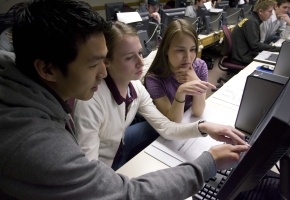Students Learn About Ups and Downs at Financial Market Simulation

BYU students are trading shares in a high-tech, fast-paced and unpredictable stock market simulation exercise.
PROVO, Utah — Apr 17, 2008 — Students at Brigham Young University hustled to maximize profits and minimize risks as they traded shares in the same high-tech, fast-paced and unpredictable stock market simulation used to train traders, strategists and salespeople at Goldman Sachs.
“The market moves very quickly, and you need to anticipate things before they happen,” says Brian Ames, a senior from North Ogden, Utah, majoring in finance. “It’s a lot less stressful when it’s not real money.”
Participants negotiated, maneuvered and at times shouted their way through the computerized simulation, officiated by London-based ACF Consultants, Ltd., which also uses the program to train new brokers on Wall Street. Ames and his teammate, Sijin Chen, a mathematics Ph.D. student from Beijing, led the pack with more than a million dollars in profit after the first day’s closing bell.
“We lost the first two rounds,” Ames says. “But we finally figured out as you help other people trade, you make money, too.”
In a large computer lab at BYU March 29-30, the simulation connected 20 teams in a network of mutually dependent traders. Each team was free to call any other team — or yell across the room — and offer to buy or sell fictional shares of various companies’ stock.
Like the real world, the stock prices responded to the behavior of the traders in the room. The teams’ valuation of the stocks also responded to a fictional news feed updated periodically by an ACF facilitator. The competition tested the students’ abilities to create markets for their stocks, manage their risk responsibly and ultimately turn a profit.
“In the investment banking world, most students know about mergers and acquisitions, but few appreciate the opportunities for lucrative and exciting careers in capital markets,” says Kim Smith, managing director of the Peery Institute of Financial Services which sponsored the exercise. “This event is a really fun and competitive way to expand their horizons.”
Eighty students with majors as diverse as economics, finance, accounting, mathematics, statistics, strategy, physics, international relations, management, organizational behavior and classical studies participated. Between rounds of trading, students received training on pertinent financial concepts, including risk management, and how to use currency exchange rates and foreign bonds to help them respond more strategically to the simulation’s dynamic threats and opportunities.
After a briefing on foreign currencies followed by a 30-minute trading session that tested participants’ ability to respond to fluctuating exchange rates, the ACF facilitator Tim Bartlett told the students, “To have just grasped the concept of foreign exchange like that, you should give yourselves a big round of applause.”
The Marriott School is located at Brigham Young University, the largest privately owned, church-sponsored university in the United States. The school has nationally recognized programs in accounting, business management, public management, information systems and entrepreneurship. The school’s mission is to prepare men and women of faith, character and professional ability for positions of leadership throughout the world. Approximately 3,000 students are enrolled in the Marriott School’s graduate and undergraduate programs.
Media Contact: Joseph Ogden (801) 422-8938 or 787-9989
Writer: Arie Dekker (801) 422-7606



